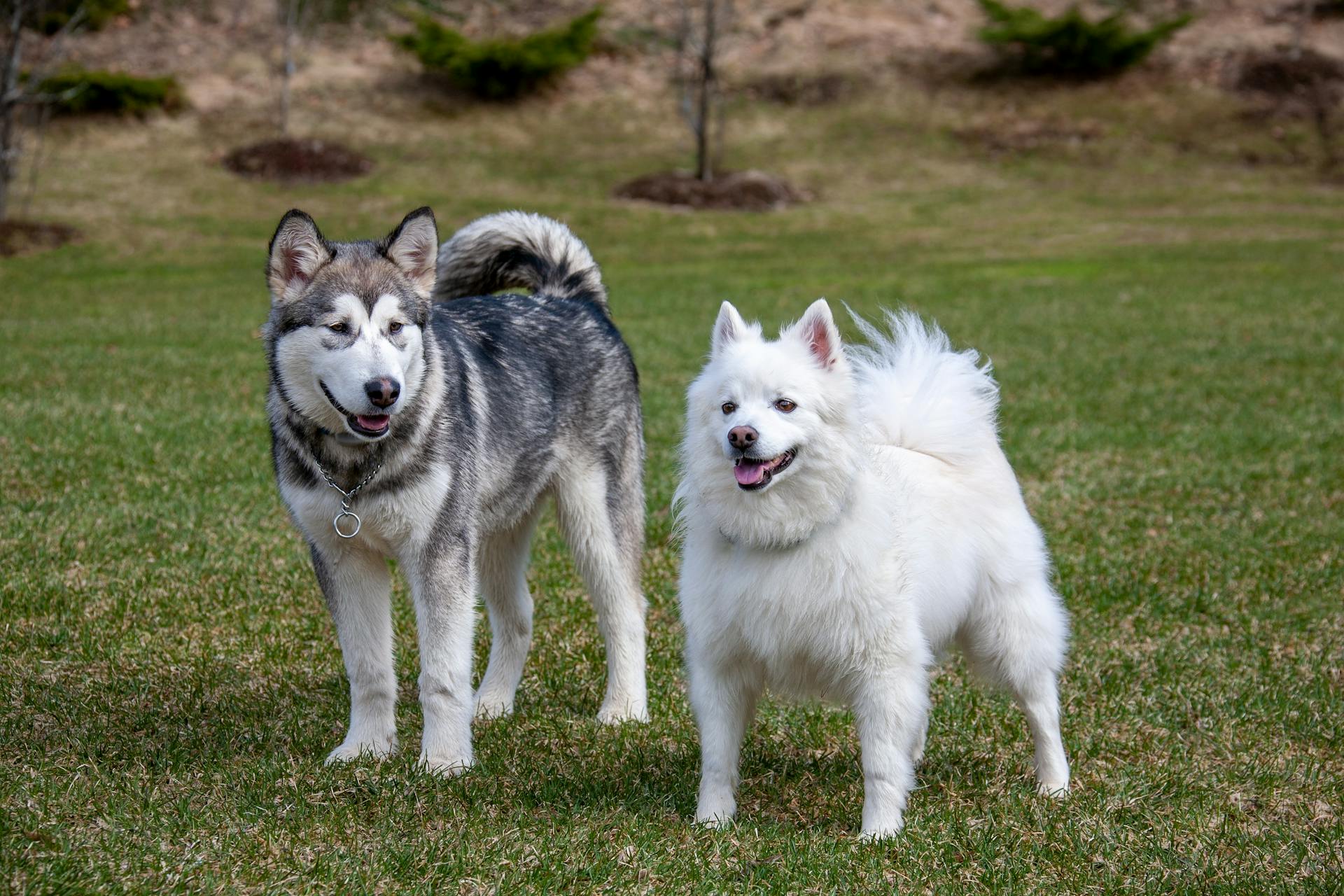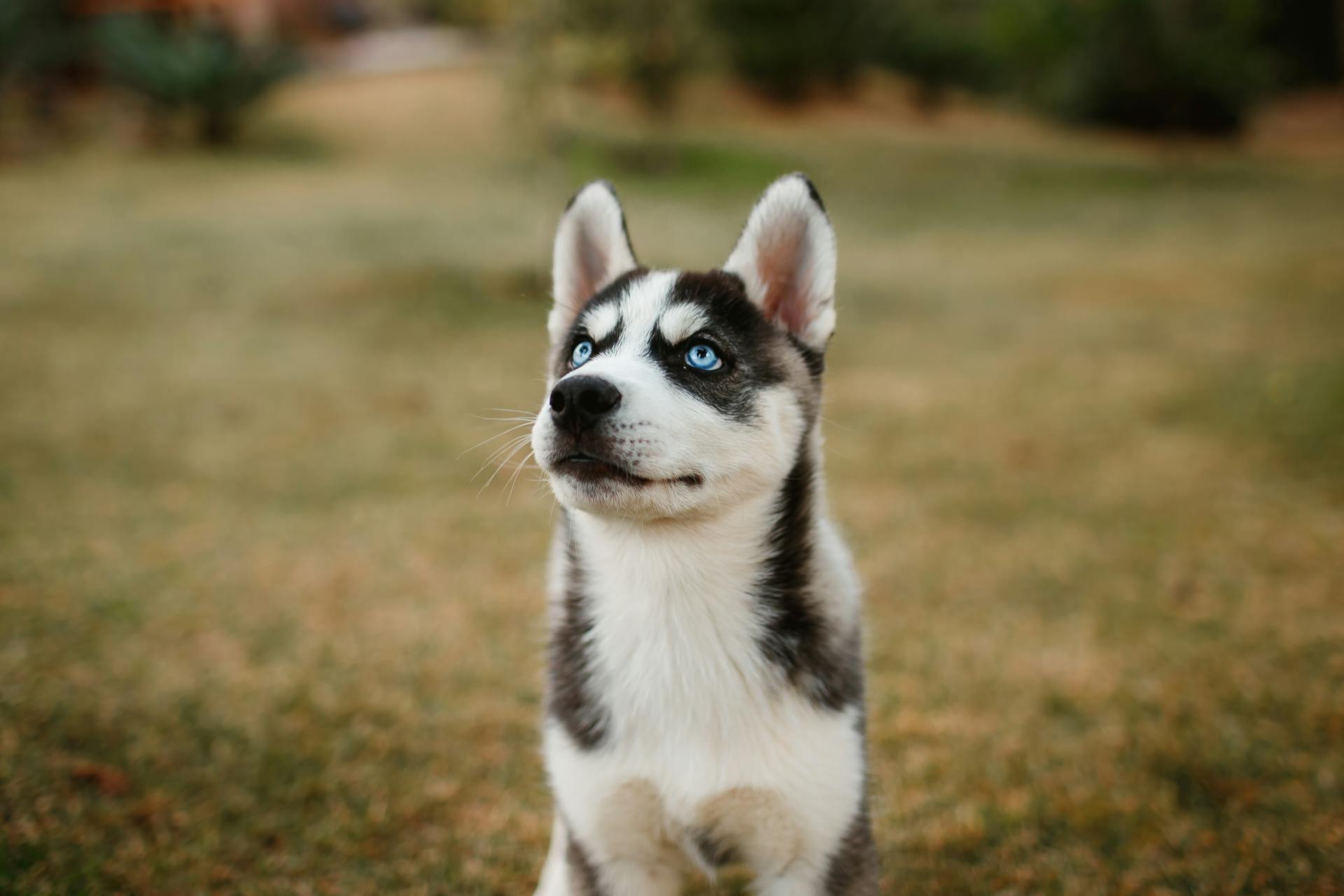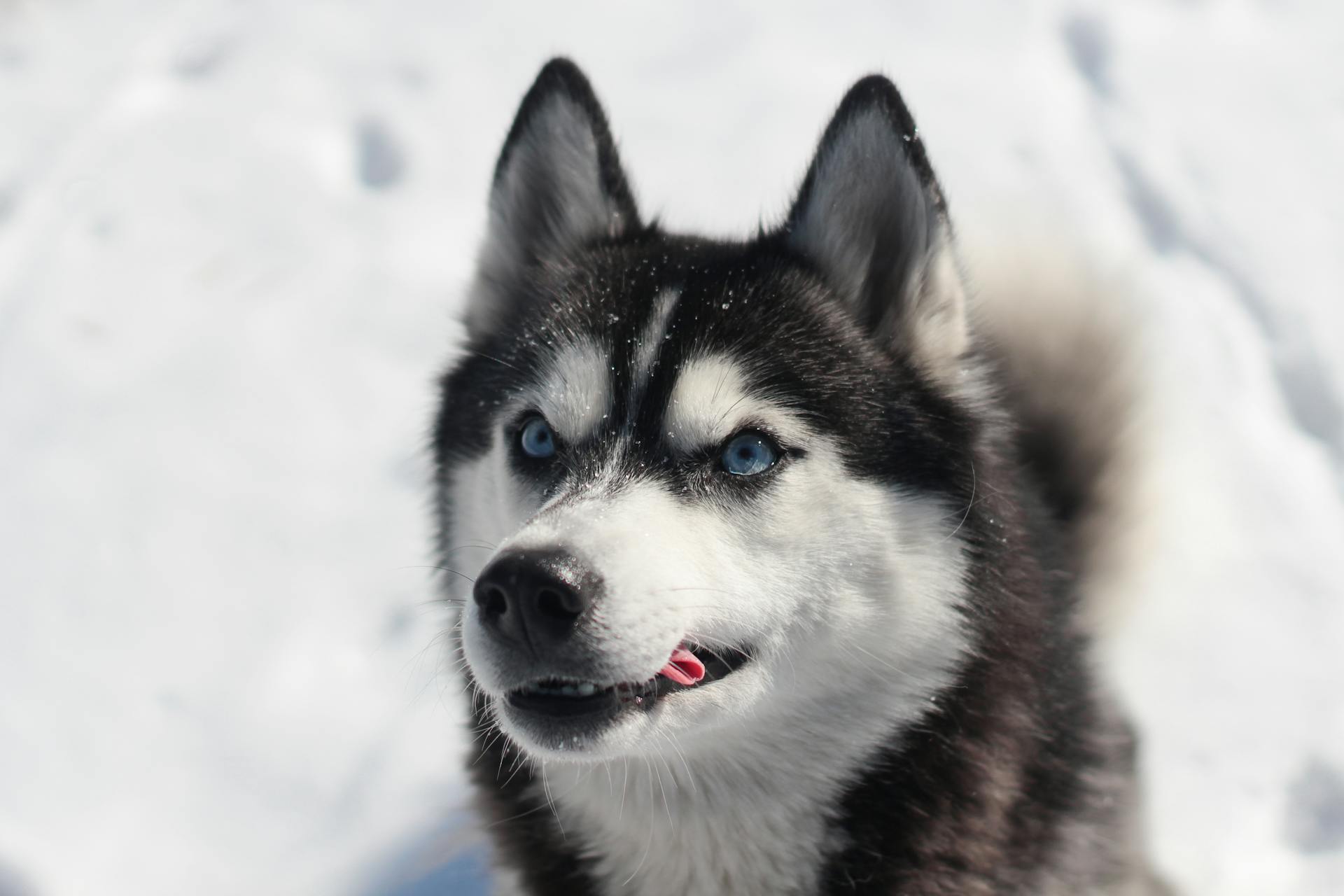
Owning a Malamute Husky can be a rewarding experience, but it's essential to understand their unique needs and characteristics.
Malamute Huskies are a cross between a Siberian Husky and an Alaskan Malamute, making them a high-energy breed that requires regular exercise.
They thrive on physical activity, needing at least 1-2 hours of exercise per day to stay happy and healthy.
Their thick coats require regular grooming to prevent matting and tangling.
Malamute Huskies are highly intelligent and trainable, but they can be stubborn at times.
Intriguing read: Good Names for Male Siberian Huskies
Breed History and Origins
The Alaskan Malamute and Siberian Husky breeds have a fascinating history that sets them apart from one another.
Siberian Huskies were bred by indigenous people in Siberia as a method of transportation for objects and people, helping them survive in harsh climates.
These dogs were prized for their sleek efficiency and ability to run long distances with minimal food.
In contrast, the Alaskan Malamute was bred by the Mahlemut tribe in Alaska as both a companion and a worker, assisting with pulling heavy loads, leading sleds, and hunting.
Malamutes were also used as guard dogs against polar bears and were known for their heartiness and ability to face near-starvation during long winters.
The Alaskan Malamute's origins date back thousands of years, with the breed being one of the most ancient Arctic breeds.
Unlike Siberian Huskies, Malamutes were bred to haul heavy loads on sleds slowly over long distances, rather than for speed.
The American Kennel Club recognized the Alaskan Malamute breed in 1935, and now they rank 67th on the AKC's list of popular dogs.
In 2010, Malamutes became Alaska's state dog, a testament to their rich history and tradition.
Physical Characteristics
Malamutes and huskies are often confused with each other, but they have some key physical differences.
One of the easiest ways to tell them apart is by their size - malamutes are generally larger than huskies.
The weight of a malamute is also typically higher than that of a husky, making it a good indicator of the breed.
Consider reading: Siberian Huskies Rescue
Eye color can also be a distinguishing feature, as huskies can have heterochromia, where they have two different colored eyes.
Malamutes, on the other hand, tend to have brown, almond-shaped eyes.
The way a dog's tail hangs can also be a good indicator of its breed - malamutes have a furry tail that curls around their back when they're not working.
Husky tails, on the other hand, tend to hang straight down.
Both malamutes and huskies have double coats, but the length of their coats is different.
Malamutes have a longer coat than huskies, with a coarse and thick top coat and an oily and wooly undercoat.
Here's a comparison of the physical characteristics of malamutes and huskies:
Care and Maintenance
Daily exercise is a must for Alaskan Malamutes, with a long walk or hike every day and vigorous games to keep them engaged. They particularly enjoy sledding and weight-pulling activities.
Alaskan Malamutes need a safe space to run, securely fenced or enclosed, as they can be escape artists. Some Malamutes are notorious for not coming when called.
Their thick coat requires daily brushing, especially during shedding seasons. Brushing once or twice a week during non-shedding seasons is also essential to keep their coat healthy and free of mats.
Daily brushing doesn't help much during shedding seasons, and a high-powered pet-grooming dryer may be necessary to blow away all that hair. Use a firm bristle brush, but avoid using a Furminator.
Their double coat helps keep them cool in the summer, and shaving won't keep them cooler. Their coat also protects them from sunburn and bug bites.
Bathing is not necessary often, as their top coat repels rain and mud. Aim for a bath every two months or so, and be sure to dry your Mal thoroughly after a bath or a swim.
Brushing their teeth at least a few times a week is crucial to keep their teeth healthy. Use a dog-appropriate toothpaste and consider a professional cleaning with your vet once a year.
Trimming their nails about every two months is also essential. If you can hear their nails click on the floor, it's time to trim them.
Suggestion: Husky Blowing Coat
Health
Malamutes and Huskies are typically healthy dogs, but hip dysplasia is a common issue in large breed dogs like them. This can range from uncomfortable to debilitating, so it's essential to research responsible breeders in your area.
Hip dysplasia is a serious health concern that can affect the quality of life for your dog. Responsible breeders will prioritize genetic testing and breeding for healthier hips.
There are risks and downsides to breeding any dogs, so it's crucial to be aware of these potential issues.
A fresh viewpoint: Giant Malamute Breeders
Behavior and Training
Malamutes and Huskies are both high-energy breeds that require plenty of mental and physical stimulation. They need activities that challenge their brains and bodies, such as obedience training, puzzle toys, and long walks.
Both breeds are escape artists, so it's essential to provide them with secure fencing and plenty of exercise to prevent them from getting bored and trying to escape. Malamutes are more likely to seize an opportunity and return to their people, while Huskies can see a locked door or closed gate as a challenge.
Related reading: Husky Hybrid Dogs
To train your Malamute or Husky, use plenty of tasty treats as rewards and short, 5-minute sessions. They can get distracted easily, so it's crucial to keep training sessions engaging and fun. Here are some key things to consider when training your Malamute or Husky:
Remember, every dog is unique, and it's essential to tailor your training approach to your dog's individual needs and personality. With patience, consistency, and positive reinforcement, you can develop a strong bond with your Malamute or Husky and help them become a well-behaved and loving companion.
A unique perspective: Husky Samoyed Dog
What's the Difference?
The Alaskan Husky's ancestry is a bit of a mystery, but it's known to include the Siberian Husky, which means they share some similarities in behavior.
Alaskan Huskies are bred for performance, not for a specific breed standard, so they can look quite different from one another.
Because of their athletic background, Alaskan Huskies are bred to be highly energetic and driven, which can make them challenging to train if you're not prepared.
Additional reading: Pictures of Husky Dogs
Alaskan Huskies and Malamutes are two distinct breeds, and understanding their differences is key to effective training and behavior management.
Alaskan Huskies can be a bit more independent than Malamutes, which can make them more difficult to train if you're not experienced.
Malamutes, on the other hand, are known for their strong work ethic and willingness to please, making them a great choice for first-time dog owners.
Prospective Owners
Choosing the right breed is crucial for a harmonious relationship with your dog. The type of breed you choose will influence its energy level, grooming needs, and training requirements.
If you're new to dog ownership, consider why you want a dog in the first place. Do you want a companion, a workout buddy, or a family pet? Understanding your motivations will help you choose a breed that fits your lifestyle.
Finding a responsible breeder is essential to ensure you're getting a healthy puppy from a reputable source. Research the breeder's reputation, ask for references, and look for certifications from organizations like the American Kennel Club.
For your interest: Characteristics of Alaskan Malamute
Getting started in dog sports can be a great way to bond with your dog and provide mental and physical stimulation. Consider activities like agility training, obedience classes, or even simply playing fetch in the park.
Puppies require a lot of attention and care, so make sure you're prepared for the demands of raising a young dog. From housebreaking to socialization, the first few months are critical in shaping your puppy's behavior and personality.
A different take: Husky Dog Female
Training
Training is essential for both Siberian Huskies and Alaskan Malamutes, as they both require mental and physical stimulation. Both breeds have high needs for exercise and mentally challenging activities like obedience training.
Their independent nature can make training a bit tricky, but with the right approach, you can overcome this challenge. Alaskan Malamutes are surprisingly easy to train, but they can get distracted easily and have a reputation for being stubborn.
To motivate your Malamute, use plenty of tasty treats as rewards and quick, 5-minute sessions instead of long, repetitive drills. If you're attending a dog training class, take breaks when your Malamute starts acting up.
Check this out: Alaskan Malamute Training
Here are some tips to keep in mind:
Obedience training is super important, as it will teach your pup the basics like sit, stay, and come, and also how to walk nicely on a leash. A tired Mal is a content Mal, so make sure to provide plenty of exercise and mental stimulation to keep them happy and healthy.
Behavior
Behavior is a crucial aspect of any dog's life, and Alaskan Malamutes are no exception. They're strong-willed and independent, which can make training a challenge.
Both Alaskan Malamutes and Siberian Huskies are high-energy breeds that require plenty of mental and physical stimulation. This includes exercise, but also activities like obedience training, puzzle toys, and sniffing around a new park.
Alaskan Malamutes are significantly less energetic than Siberian Huskies, and their energy levels should be considered when deciding on a breed. Malamutes are also more prone to escape attempts, often trying to open gates or dig under fences.
Malamutes prefer pulling over running as their exercise, which is great for activities like bikejoring or sled pulling. They also love to dig, and if bored, may dig under fences or chew up furniture.
If you're considering an Alaskan Malamute, it's essential to socialize them properly and train them from an early age. They can be strong-willed and may not respond well to other dogs if not properly trained.
Here are some key differences in Malamute behavior to consider:
Overall, Alaskan Malamutes are intelligent, loyal, and loving companions that require attention, training, and exercise to thrive. With the right approach, they can become wonderful family pets.
Frequently Asked Questions
What is a husky Malamute mix called?
The Alusky is a hybrid dog breed resulting from a Siberian Husky and Alaskan Malamute cross. This energetic mix makes a great pet for active families or couples.
How big will a husky Malamute get?
A Husky Malamute can weigh between 60 to 100 pounds and stand between 20 to 28 inches tall. This mixed breed's size can vary, making them a unique and interesting companion.
How can I tell if my husky is a Malamute?
To determine if your husky is a Malamute, check if its tail curls over its back. If so, it's likely an Alaskan Malamute, but if it hangs straight down, it's probably a Siberian Husky.
Sources
- https://www.britannica.com/animal/Alaskan-Malamute
- https://rockykanaka.com/malamute-vs-husky-whats-the-difference-between-these-fluffy-sled-dog-breeds/
- https://www.akc.org/dog-breeds/alaskan-malamute/
- https://be.chewy.com/dog-breed/alaskan-malamute/
- https://www.wikihow.com/Identify-an-Alaskan-Malamute-from-a-Siberian-Husky
Featured Images: pexels.com


